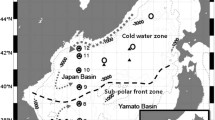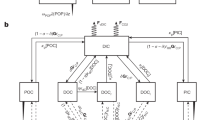Abstract
Dissolved organic carbon (DOC) is a carbon reservoir that is as large as the atmospheric CO2 pool, and its contribution to the global carbon cycle is gaining attention. As DOC is a dissolved tracer, its distribution can serve to trace the mixing of water masses and the pathways of ocean circulation. Published proxy and model reconstructions have revealed that, during the last glacial maximum (LGM), the pattern of deep ocean circulation differed from that of the modern ocean, whereby additional carbon is assumed to have been sequestered in stratified LGM deep water. The aim of this study is to explore the distribution of DOC and its production/removal rate during the LGM using the Grid ENabled Integrated Earth system model (GENIE). Modeled results reveal that increased salinity of bottom waters in the Southern Ocean is associated with stronger stratification and oxygen depletion. The stratified LGM deep ocean traps more nutrients, resulting in a decrease in the DOC reservoir size that, in turn, causes a negative feedback for carbon sequestration. This finding requires an increase in DOC lifetime to compensate for the negative feedback. The upper limit of DOC lifetime is assumed to be 20,000 years. Modeled results derive an increase (decrease) in DOC reservoir by 100 Pg C leading to an atmospheric CO2 decrease (increase) of 9.1 ppm and a dissolved inorganic carbon δ13C increase (decrease) of 0.06‰. The DOC removal rate is estimated to be 39.5 Tg C year–1 in the deep sea during the LGM. The contribution of DOC to the LGM carbon cycle elucidates potential carbon sink-increasing strategies.






Similar content being viewed by others
References
Adkins JF (2013) The role of deep ocean circulation in setting glacial climates. Paleoceanography 28:539–561. doi:10.1002/palo.20046
Anderson LG (2002) DOC in the Arctic Ocean. In: Hansell DA, Carlson CA (eds) Biogeochemistry of marine dissolved organic matter. Academic Press, Amsterdam, pp 665–683
Archer D, Maierreimer E (1994) Effect of deep-sea sedimentary calcite preservation on atmospheric CO2 concentration. Nature 367:260–263. doi:10.1038/367260a0
Berger A (1978) Long-term variations of daily insolation and Quaternary climatic changes. J Atmos Sci 35:2362–2367. doi:10.1175/1520-0469(1978)035<2362:LTVODI>2.0.CO;2
Bouttes N, Paillard D, Roche DM (2010) Impact of brine-induced stratification on the glacial carbon cycle. Clim Past 6:575–589. doi:10.5194/cp-6-575-2010
Bouttes N, Paillard D, Roche DM, Waelbroeck C, Kageyama M, Lourantou A, Michel E, Bopp L (2012) Impact of oceanic processes on the carbon cycle during the last termination. Clim Past 8:149–170. doi:10.5194/cp-8-149-2012
Boyle EA (1988) The role of vertical chemical fractionation in controlling late Quaternary atmospheric carbon dioxide. J Geophys Res Oceans 93:15701–15714. doi:10.1029/JC093iC12p15701
Broecker WS (1991) The great ocean conveyor. Oceanography 4:79–89
Broecker WS, Peng T-H (1982) Tracers in the sea. Eldigio Press, Palisades, NY
Broecker WS, Peng T-H (1987) The role of CaCO3 compensation in the glacial to interglacial atmospheric CO2 change. Global Biogeochem Cycles 1:15–29. doi:10.1029/GB001i001p00015
Cao L, Eby M, Ridgwell A, Caldeira K, Archer D, Ishida A, Joos F, Matsumoto K, Mikolajewicz U, Mouchet A, Orr JC, Plattner GK, Schlitzer R, Tokos K, Totterdell I, Tschumi T, Yamanaka Y, Yool A (2009) The role of ocean transport in the uptake of anthropogenic CO2. Biogeosciences 6:375–390. doi:10.5194/bg-6-375-2009
Capotondi A, Alexander MA, Bond NA, Curchitser EN, Scott JD (2012) Enhanced upper ocean stratification with climate change in the CMIP3 models. J Geophys Res Oceans 117, C04031. doi:10.1029/2011JC007409
Carlson CA (2002) Production and removal processes. In: Hansell DA, Carlson CA (eds) Biogeochemistry of marine dissolved organic matter. Academic Press, Amsterdam, pp 91–151
Ciais P, Tagliabue A, Cuntz M, Bopp L, Scholze M, Hoffmann G, Lourantou A, Harrison SP, Prentice IC, Kelley DI, Koven C, Piao SL (2012) Large inert carbon pool in the terrestrial biosphere during the Last Glacial Maximum. Nature Geosci 5:74–79. doi:10.1038/ngeo1324
Curry WB, Oppo DW (2005) Glacial water mass geometry and the distribution of δ13C of ΣCO2 in the western Atlantic Ocean. Paleoceanography 20, PA1017. doi:10.1029/2004PA001021
Dugdale RC (1967) Nutrient limitation in the sea: dynamics, identification, and significance. Limnol Oceanogr 12:685–695
Dunne JP, Armstrong RA, Gnanadesikan A, Sarmiento JL (2005) Empirical and mechanistic models for the particle export ratio. Global Biogeochem Cycles 19, GB4026. doi:10.1029/2004GB002390
Edwards N, Marsh R (2005) Uncertainties due to transport-parameter sensitivity in an efficient 3-D ocean-climate model. Clim Dyn 24:415–433. doi:10.1007/s00382-004-0508-8
Eppley RW, Peterson BJ (1979) Particulate organic matter flux and planktonic new production in the deep ocean. Nature 282:677–680. doi:10.1038/282677a0
Falkowski PG, Oliver MJ (2007) Mix and match: how climate selects phytoplankton. Nature Rev Microbiol 5:813–819. doi:10.1038/nrmicro1751
Galbraith ED, Jaccard SL, Pedersen TF, Sigman DM, Haug GH, Cook M, Southon JR, Francois R (2007) Carbon dioxide release from the North Pacific abyss during the last deglaciation. Nature 449:890–893. doi:10.1038/nature06227
Hansell DA (2013) Recalcitrant dissolved organic carbon fractions. Annu Rev Mar Sci 5:421–445. doi:10.1146/annurev-marine-120710-100757
Hansell DA, Carlson CA (1998) Deep-ocean gradients in the concentration of dissolved organic carbon. Nature 395:263–266. doi:10.1038/26200
Hansell DA, Carlson CA (2013) Localized refractory dissolved organic carbon sinks in the deep ocean. Global Biogeochem Cycles 27:705–710. doi:10.1002/GBC.20067
Hansell DA, Carlson CA, Repeta DJ, Schlitzer R (2009) Dissolved organic matter in the ocean: a controversy stimulates new insights. Oceanography 22:202–211. doi:10.5670/oceanog.2009.109
Hansell DA, Carlson CA, Schlitzer R (2012) Net removal of major marine dissolved organic carbon fractions in the subsurface ocean. Global Biogeochem Cycles 26, GB1016. doi:10.1029/2011GB004069
Jaccard SL, Galbraith ED, Sigman DM, Haug GH, Francois R, Pedersen TF, Dulski P, Thierstein HR (2009) Subarctic Pacific evidence for a glacial deepening of the oceanic respired carbon pool. Earth Planet Sci Lett 277:156–165. doi:10.1016/j.epsl.2008.10.017
Jaccard SL, Hayes CT, Martinez-Garcia A, Hodell DA, Anderson RF, Sigman DM, Haug GH (2013) Two modes of change in Southern Ocean productivity over the past million years. Science 339:1419–1423. doi:10.1126/science.1227545
Jiao N, Herndl GJ, Hansell DA, Benner R, Kattner G, Wilhelm SW, Kirchman DL, Weinbauer MG, Luo T, Chen F, Azam F (2010) Microbial production of recalcitrant dissolved organic matter: long-term carbon storage in the global ocean. Nature Rev Microbiol 8:593–599. doi:10.1038/nrmicro2386
Jiao N, Tang K, Cai H, Mao Y (2011) Increasing the microbial carbon sink in the sea by reducing chemical fertilization on the land. Nature Rev Microbiol 9:75–75. doi:10.1038/nrmicro2386-c2
Jiao N, Zhang Y, Zhou K, Li Q, Dai M, Liu J, Guo J, Huang B (2014) Revisiting the CO2 “source” problem in upwelling areas – a comparative study on eddy upwellings in the South China Sea. Biogeosciences 11:2465–2475. doi:10.5194/bg-11-2465-2014
Köhler P, Fischer H, Munhoven G, Zeebe RE (2005) Quantitative interpretation of atmospheric carbon records over the last glacial termination. Global Biogeochem Cycles 19, GB4020. doi:10.1029/2004GB002345
Lüthi D, Le Floch M, Bereiter B, Blunier T, Barnola J-M, Siegenthaler U, Raynaud D, Jouzel J, Fischer H, Kawamura K, Stocker TF (2008) High-resolution carbon dioxide concentration record 650,000-800,000 years before present. Nature 453:379–382. doi:10.1038/nature06949
Mahowald NM, Muhs DR, Levis S, Rasch PJ, Yoshioka M, Zender CS, Luo C (2006) Change in atmospheric mineral aerosols in response to climate: last glacial period, preindustrial, modern, and doubled carbon dioxide climates. J Geophys Res Atmos 111, D10202. doi:10.1029/2005JD006653
Marsh R, Müller SA, Yool A, Edwards NR (2011) Incorporation of the C-GOLDSTEIN efficient climate model into the GENIE framework: “eb_go_gs” configurations of GENIE. Geosci Model Dev 4:957–992. doi:10.5194/gmd-4-957-2011
Martin JH, Coale KH, Johnson KS, Fitzwater SE, Gordon RM, Tanner SJ, Hunter CN, Elrod VA, Nowicki JL, Coley TL, Barber RT, Lindley S, Watson AJ, Van Scoy K, Law CS, Liddicoat MI, Ling R, Stanton T, Stockel J, Collins C, Anderson A, Bidigare R, Ondrusek M, Latasa M, Millero FJ, Lee K, Yao W, Zhang JZ, Friederich G, Sakamoto C, Chavez F, Buck K, Kolber Z, Greene R, Falkowski P, Chisholm SW, Hoge F, Swift R, Yungel J, Turner S, Nightingale P, Hatton A, Liss P, Tindale NW (1994) Testing the iron hypothesis in ecosystems of the equatorial Pacific Ocean. Nature 371:123–129. doi:10.1038/371123a0
Menviel L, Joos F, Ritz SP (2012) Simulating atmospheric CO2, 13C and the marine carbon cycle during the Last Glacial–Interglacial cycle: possible role for a deepening of the mean remineralization depth and an increase in the oceanic nutrient inventory. Quat Sci Rev 56:46–68. doi:10.1016/j.quascirev.2012.09.012
Munhoven G (2002) Glacial–interglacial changes of continental weathering: estimates of the related CO2 and HCO3 − flux variations and their uncertainties. Global Planet Change 33:155–176. doi:10.1016/S0921-8181(02)00068-1
Otto D, Rasse D, Kaplan J, Warnant P, François L (2002) Biospheric carbon stocks reconstructed at the Last Glacial Maximum: comparison between general circulation models using prescribed and computed sea surface temperatures. Global Planet Change 33:117–138. doi:10.1016/S0921-8181(02)00066-8
Petit JR, Jouzel J, Raynaud D, Barkov NI, Barnola JM, Basile I, Bender M, Chappellaz J, Davis M, Delaygue G, Delmotte M, Kotlyakov VM, Legrand M, Lipenkov VY, Lorius C, Pepin L, Ritz C, Saltzman E, Stievenard M (1999) Climate and atmospheric history of the past 420,000 years from the Vostok ice core, Antarctica. Nature 399:429–436. doi:10.1038/20859
Pflaumann U, Sarnthein M, Chapman M, d’Abreu L, Funnell B, Huels M, Kiefer T, Maslin M, Schulz H, Swallow J, van Kreveld S, Vautravers M, Vogelsang E, Weinelt M (2003) Glacial North Atlantic: sea-surface conditions reconstructed by GLAMAP 2000. Paleoceanography 18:1065. doi:10.1029/2002PA000774
Ridgwell A (2001) Glacial-interglacial perturbations in the global carbon cycle. PhD thesis, University of East Anglia, Norwich, UK
Ridgwell A (2011) Evolution of the ocean’s “biological pump”. Proc Natl Acad Sci 108:16485–16486. doi:10.1073/pnas.1112236108
Ridgwell A, Hargreaves JC, Edwards NR, Annan JD, Lenton TM, Marsh R, Yool A, Watson A (2007) Marine geochemical data assimilation in an efficient Earth System Model of global biogeochemical cycling. Biogeosciences 4:87–104
Rothman DH, Hayes JM, Summons RE (2003) Dynamics of the Neoproterozoic carbon cycle. Proc Natl Acad Sci 100:8124–8129. doi:10.1073/pnas.0832439100
Sarmiento JL, Toggweiler JR (1984) A new model for the role of the oceans in determining atmospheric P CO2. Nature 308:621–624
Sarnthein M, Schneider B, Grootes PM (2013) Peak glacial 14C ventilation ages suggest major draw-down of carbon into the abyssal ocean. Clim Past 9:2595–2614. doi:10.5194/cp-9-2595-2013
Sexton PF, Norris RD, Wilson PA, Pälike H, Westerhold T, Röhl U, Bolton CT, Gibbs S (2011) Eocene global warming events driven by ventilation of oceanic dissolved organic carbon. Nature 471:349–352. doi:10.1038/nature09826
Siegenthaler U, Wenk T (1984) Rapid atmospheric CO2 variations and ocean circulation. Nature 308:624–626
Siegenthaler U, Stocker TF, Monnin E, Lüthi D, Schwander J, Stauffer B, Raynaud D, Barnola J-M, Fischer H, Masson-Delmotte V, Jouzel J (2005) Stable carbon cycle-climate relationship during the late Pleistocene. Science 310:1313–1317. doi:10.1126/science.1120130
Sigman DM, Boyle EA (2000) Glacial/interglacial variations in atmospheric carbon dioxide. Nature 407:859–869. doi:10.1038/35038000
Sigman DM, Hain MP, Haug GH (2010) The polar ocean and glacial cycles in atmospheric CO2 concentration. Nature 466:47–55. doi:10.1038/nature09149
Sikes EL, Samson CR, Guilderson TP, Howard WR (2000) Old radiocarbon ages in the southwest Pacific Ocean during the last glacial period and deglaciation. Nature 405:555–559. doi:10.1038/35014581
Tagliabue A, Bopp L, Roche DM, Bouttes N, Dutay J-C, Alkama R, Kageyama M, Michel E, Paillard D (2009) Quantifying the roles of ocean circulation and biogeochemistry in governing ocean carbon-13 and atmospheric carbon dioxide at the last glacial maximum. Clim Past 5:695–706. doi:10.5194/cp-5-695-2009
Wang P, Tian J, Lourens LJ (2010) Obscuring of long eccentricity cyclicity in Pleistocene oceanic carbon isotope records. Earth Planet Sci Lett 290:319–330. doi:10.1016/j.epsl.2009.12.028
Wang P, Li Q, Tian J, Jian Z, Liu C, Li L, Ma W (2014) Long-term cycles in the carbon reservoir of the Quaternary ocean: a perspective from the South China Sea. Natl Sci Rev 1:119–143. doi:10.1093/nsr/nwt028
Williams PM, Druffel ERM (1987) Radiocarbon in dissolved organic matter in the central North Pacific Ocean. Nature 330:246–248
Yamanaka Y, Tajika E (1997) Role of dissolved organic matter in the marine biogeochemical cycle: studies using an ocean biogeochemical general circulation-model. Global Biogeochem Cycles 11:599–612. doi:10.1029/97GB02301
Acknowledgements
Constructive comments and corrections from an anonymous reviewer and the editors are acknowledged. Funding for this research was provided by the NSFC (Grant Nos. 41206033, 91128208), Shanghai Shu Guang Program (11SG24), Shanghai Human Development Fund (201336), and State Key Laboratory of Marine Geology (MG20130201).
Author information
Authors and Affiliations
Corresponding author
Rights and permissions
About this article
Cite this article
Ma, W., Tian, J. Modeling the contribution of dissolved organic carbon to carbon sequestration during the last glacial maximum. Geo-Mar Lett 34, 471–482 (2014). https://doi.org/10.1007/s00367-014-0378-y
Received:
Accepted:
Published:
Issue Date:
DOI: https://doi.org/10.1007/s00367-014-0378-y




